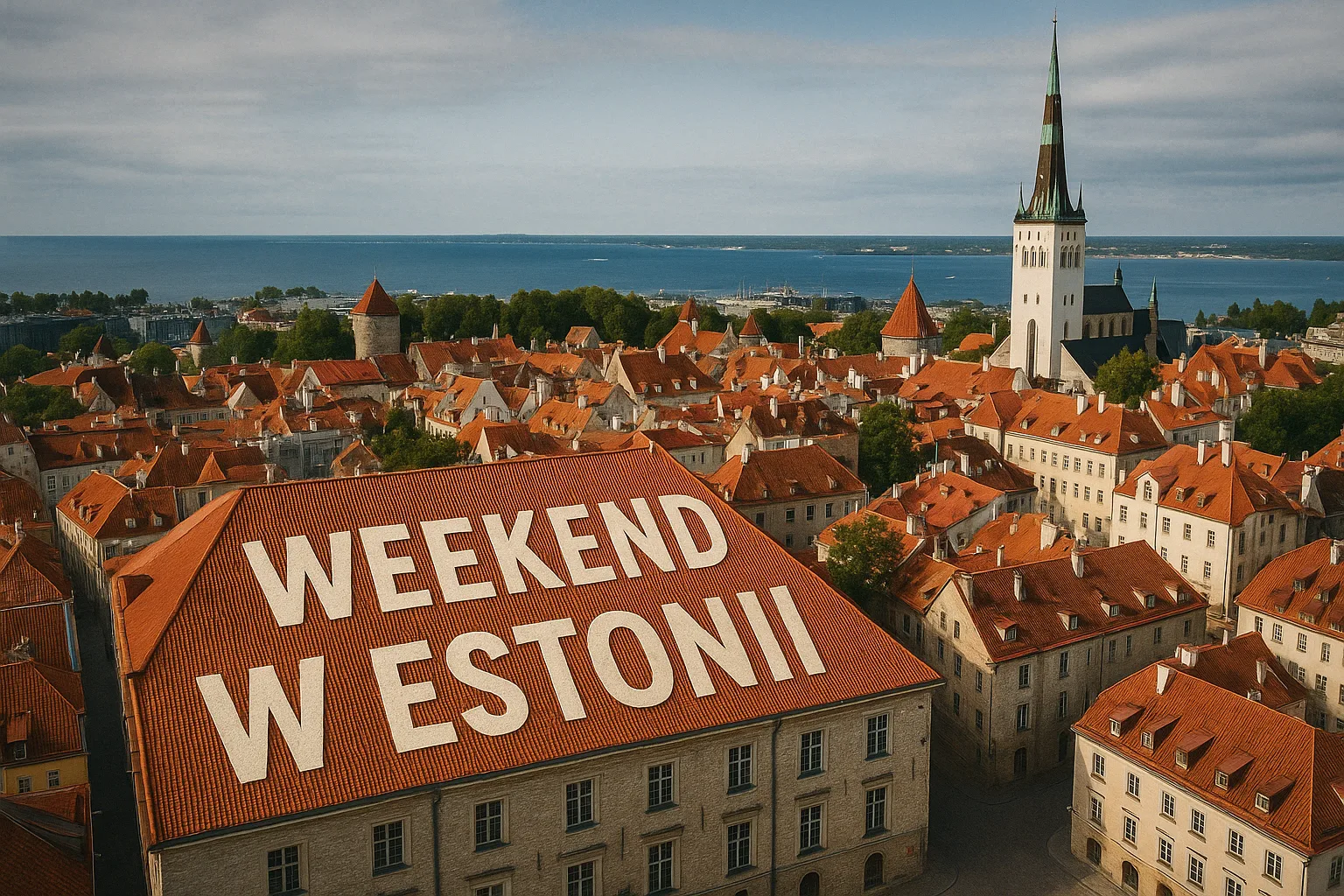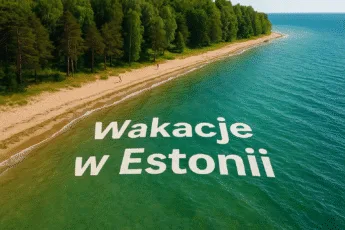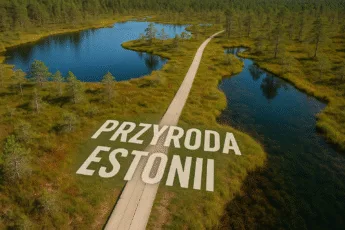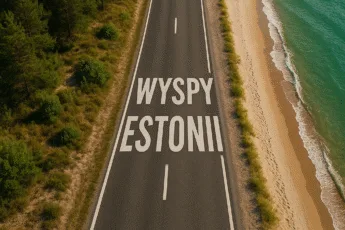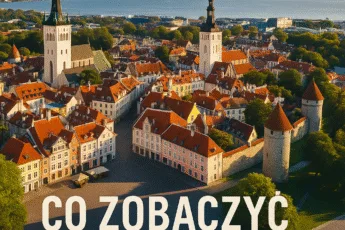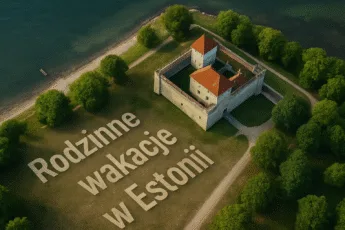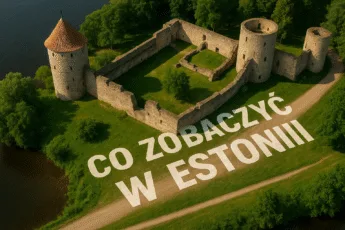You dream of a short trip to Estonia , but you don't know where to start? This non -obvious direction will surprise you with diversity: from picturesque towns and Baltic beaches to modern cafes and wildlife. If you are planning City Break in Tallinn or a weekend among lakes and castles, look at the full guide after the holidays in Estonia 2025 -there you will find current prices, routes and plan of a 7-day journey.
How to plan a weekend in Estonia? A guide for beginner travelers
The weekend in Estonia does not require months of preparation or a large budget - it is key to good time planning and a conscious selection of the route. Two or three days are enough to see the most interesting, but only if you do not overload the plan. Estonia is a country of short distances, functional transport and intimate attractions - that's why a short trip can be really intense, but without pressure and rush.
The best time to go - weather and season
Estonia lies in the cool moderate climate zone, which means large differences between seasons. The best time for a weekend trip is the period from mid -May to mid -September - the days are long (in June up to 18 hours of daylight), moderate temperatures (18-24 ° C), and the weather is stable. It is worth avoiding November and February - these are the darkest and most rainy months. If you want to see Estonia in winter, choose the turn of December and January when you can count on snow and holiday fairs.
How many days are enough to feel the atmosphere of Estonia?
For most travelers, the ideal solution is a 2-3-day trip . Two days will allow you to visit Tallinn (Old Town, Kadriorg, Telliskivi, Port) and taste local cuisine in the evening. Three days give the opportunity to get a trip to Tartu, Haapsal or Lahmaa National Park. The distances between the main points are small - e.g. from Tallinn to Tartu is 186 km (2.5 hours of driving), and to Parnawa - 128 hp (1.5 hours). In the case of leaving Poland, it is worth adding time for a flight (about 1.5 Hz Warsaw, Krakow or Gdańsk) and a transfer from the airport.
How to get to Estonia for the weekend - by plane, car or ferry?
Estonia is one of the most easily available Baltic countries - especially for a short trip from Poland. Thanks to cheap flights to Tallinn, ferry networks from Nordic countries and good roads through Lithuania and Latvia, reaching a place is not a problem. Just one evening of planning to choose the optimal means of transport , adapted to the time, budget and preferred travel style.
By plane: the cheapest connections and airports
For the needs of the weekend, the plane is the fastest and most convenient option . Warsaw (Wizz Air and LOT), Kraków (Ryanair) and Gdańsk (Ryanair) offer the most connections. The average flight time to Tallinn is 1 hour and 35 minutes. Ticket prices start from 89 PLN in two ways (buying 4-6 weeks in advance), and the real cost when booking a week before the journey is 250–450 PLN. The airport in Tallinn (TLL) is located only 4 km from the city center - access by tram No. 4 takes 17 minutes and costs 1.50 euros.
By car, train, ferry - what pays off?
For people who want to connect a journey with the exploration of the Baltic countries, access by car is a real option. There are about 960 km from Warsaw to Tallinn (travel time: 12-14 hours without interruptions). The route through Lithuania and Latvia runs along the main international roads and does not require vignettes. The cost of fuel both ways is an average of PLN 700-900 (when burning 6.5 l/100 km and a price of 6.9 PLN/l). By train directly to Estonia can not be reached - you have to change in Vilnius and Riga, which takes a total of 20-26 hours. A ferry from Finland (Helsinki -Ottallinn) can be an addition to flight, but not an independent option from Poland.
| Means of transport | Average travel time | Approximate cost (both ways) |
|---|---|---|
| Aircraft (Warsaw -Otallinn) | 1 h 35 min | PLN 89–450 |
| Car (Warsaw -Otallinn) | 12-14 h | 700–900 PLN (fuel) |
| Train + transfers | 20–26 h | PLN 350-500 |
| Ferry (Helsinki -Otallinn) | 2 h (from Helsinki) | PLN 80-120 |
Where to go for the weekend in Estonia - Tallinn or something less obvious?
Most tourists going for the weekend in Estonia go to Tallinn - and rightly so, because it is one of the best preserved medieval cities in Europe. But this is not the only option. This country has more to offer than just the capital: university tarts, seaside Parnawa or Haapsal spa are directions that you can easily fit in the 2-3-day trip . What's more, most of them are a maximum of 2-2.5 hours from Tallinn, which means that even a short stay can be diverse.
👉 See also: What to see in Estonia - cities, nature, islands and relaxation
Tallinn - classic city break
It is no accident that Tallinn appears in every recommendation. His old town was inscribed on the UNESCO list as early as 1997 and remains consistently the main goal of tourists. But it's worth knowing that these are not only monuments. In the Telliskivi district you will find modern art galleries, independent bookstores, restaurants with local products and one of the best cafes in the Baltic countries - "Røst". In turn, the Kadriorg Park and the castle turned into a museum is the perfect route for Saturday afternoon. Importantly, the city center can be visited on foot - you don't need a car or public transport.
Alternatives: Tartu, Parnawa, Haapsal
Tartu, the second largest city in Estonia, is the intellectual and cultural heart of the country. It offers not only the university from 1632, but also modern museums such as Ahhaa or Ester. You drive here 2.5 hours (bus or train) from Tallinn. Parnawa - this is a seaside resort with a long beach and the thermal SPA, ideal for relaxation. Distance from Tallinn: 130 km (about 1.5 hours). Haapsal is a pearl of the west coast - with a castle, wooden buildings and peace that you will not find in larger cities. All three places can be visited without the need for accommodation if you start the day early and use intercity communication.
- Tallinn - the capital with history, art and gastronomy (1-2 days)
- Tartu - culture, science, modern museums (1 day or with accommodation)
- Parnawa - sea, spa, promenade and relaxation (1 day)
What to see in Tallinn in 2 days - a plan to visit step by step
If you have only 48 hours at Tallinn , the key is to plan each day well. The capital of Estonia combines medieval architecture with modern culture and great cuisine. All key attractions are concentrated within 3 kilometers, which allows you to visit the city on foot. This plan will allow you to see not only classics, but also less obvious places.
Old Town, Vieweno points and Topea Castle
Start with the Old Town inscribed on the UNESCO list. The passage from the Virus gate to the Town Hall Square will take no more than 15 minutes, but it is worth stopping - every street is a different story. It is mandatory to enter the Kohtuots observation platform (open around the clock, free) - a panorama of Tallinn roofs with a view of the port and modern districts at any time of the year. Then head to the Toypea castle - the current headquarters of the Estonian parliament. Admission to the courtyard is free, from the nearby Tower of Pikk Hermann (height 45 m) every day at 7:00 the anthem of Estonia resounds - a symbolic beginning of the day.
Culture and relaxation: museums, pubs, night atmosphere
After the historic part, it's time for the modern installment of the city. In the Telliskivi district you will find photographers Tallinn - a branch of the Swedish Photography Center (ticket: 15 €, open every day). Next to it operates the iconic "F-Hoone" cafe and the craft brewery "Põhjala". In the afternoon, visit the Kadriorg district: Piotr I Baroque Palace, Galeria Kumu (ticket: 12 €, architecture in the style of the 21st century) and a park full of fountains and walking alleys. In the evening it is worth returning to the center - restaurants in the area of Rataskaev and Lai 29 offer modern Estonian cuisine, and "Speakeas" bars (e.g. Parrot Minibar) are open until late, even a week.
- Old Town - Town Hall Square, City Walls, PIKK street
- Kohtuutes - the best free viewpoint
- Topea Castle - Parliament's seat, Hermann Pikk Tower
- Telliskivi - museums, street art, alternative scene
- Kadriorg - Palace, Park and Galeria Kumu
- Night scene - pubs, bars and modern kitchen
- Castles and palaces - if Tallinn inspires you, check the other most beautiful castles and palaces in Estonia - many of them are only 1-2 hours of driving from the capital.
Tartu - Estonian soul in a nutshell: an ideal place for the weekend?
Although Tallinn dominates the guides, Tartu is considered the real heart of Estonia. The second largest city of the country, located on the Emajõga River, offers the perfect combination of history, modernity and intellectual atmosphere. If you are looking for a place for a calmer, but equally valuable weekend - it is worth considering Tartu . From Tallinn you will get here in 2.5 hours by fast bus (Lux Express) or by Elron train. This is a real alternative even for a short trip.
A walk around the university city
The University of Tartu, founded in 1632 by Gustaw II Adolf, still shapes the city's atmosphere. The historic main building at ülikooli Street is a must - open every day for visitors (entering the free courtyard). Right next to you you will find the famous monument to the kiss, and 500 meters away - the Toomemägi Park with the ruins of the cathedral and the viewing terraces. It is worth taking a walk along Rüütli Street, where the most interesting stores, cafes and galleries are focused. The city is compact - the whole center can be passed in 40 minutes without losing any important point.
Modern museums and a cafe climate
Tartu is also the capital of Estonian modern education and science. Centrum Ahhaa - the largest science center in the Baltic countries - this is a must -have point even for adults (ticket: 15 €, sightseeing time: 2-3 hours). Right next to it is the Estonian National Museum (ERM) - located in a former 355 m long hanger, presents the culture, language and history of the region in an interactive way (ticket: 12 €). After the visit, it is worth sitting in one of the cafe at Jakobi or Gildi - in Tartu, the culture of cafes is not a fashion, but a ritual. Coffee prices start from 2.50 €, and many places offer local pastries and literary presses on tables.
The best ideas for an active weekend in the nature of Estonia
Estonia is not only cities and the coast - it is primarily a country of forests, lakes, peat bogs and Baltic wildlife. Nearly 50% of the area are covered with forests, and 5 national parks and dozens of reserves offer ideal conditions for active rest in nature . If you are wondering what to do in Estonia in the summer , and you are not just interested in sightseeing, this block is just for you.
Hiking and bicycle routes
The Estonian network of pedestrian and bicycle routes is one of the best developed in the Baltic region. In the Lahmaa National Park - 70 km away from Tallinn - you will find over 20 marked routes from 3 to 18 km long. The Virus Raba trail leading through a peat bog with a wooden footbridge and an observation tower (length: 3.5 km, availability throughout the year) is particularly recommended. In the Soomaa Park, in turn, you can combine hiking with observation of wild animals - deer, elk and otter. Bicycle routes connect, among others Parnava with coastal villages and have the status of the European route Eurovelo 10 - in Estonia it is over 900 km of marked road.
Kayaking, swamps, national parks
Summer weekend in Estonia is an ideal opportunity for kayaking - especially in the Soomaa National Park, known from the "Fifth Section of the Year", when the rivers are pouring and flooding the forests in spring. In the summer, the water level stabilizes and allows safe routes for beginners. Kayaks can be borrowed, e.g. at points at Tammeor or Riis, cost: approx. € 25-35 per day. In the Matsal Park, known for migrating birds, it is possible to observe breeding species from Łódź or observation towers. If you are looking for something less standard - the Endla reserve offers night walks around the swamps with a local guide (in the season: June -August).
- Viru Raba - Torfowisko with a tower and footbridge in Lahmaa (3.5 km, free)
- Soomaa - kayaks, wildlife, fifth time of year
- Matesal - birds, boats, observation towers
- Eurovelo 10 - a coastal bicycle route throughout Estonia
- Endla - marsh night tours with a local guide
Weekend by the sea? Estonia beaches are more than sand
Although Estonia is not associated with a typical beach rest, its coast on the Baltic Sea is over 3,700 km of shoreline - of which the beaches are available even during a short weekend trip . From the wide, sandy bathing areas to hidden bays only on foot or by bike - the choice is surprisingly rich.
👉 See also: Estonia beaches - where to the Baltic Sea?
Parnawa - Estonian resort number 1
Located 130 km southwest of Tallinn Parnawa is the most famous seaside resort of Estonia. The local beach is over 2 km long, a wide range of white sand, plate water ideal for families with children and infrastructure: toilets, changing rooms, volleyball courts, playgrounds. The bath season lasts here from mid -June to the end of August, and the average water temperature is 18-21 ° C. Cafe and bars operate along the promenade, and in the city center there are numerous SPA and hotels. Parnawa beach is regularly rewarded with a blue flag for purity and availability.
Small, wild bays and beaches outside the trail
If you are looking for peace and contact with nature, it is worth driving a few kilometers from the main cities. The beach in Valgeranna (8 km from Parnawa) is a good combination of nature and infrastructure - with an observation tower, educational path and pine forest. Even more wild is the beach in cables, near the border with Latvia - with observation points for ornithologists and campsite in the forest. In the north of the country, it is worth visiting the beaches near Laulasmaa and Vääna-Jõesuu-often visited by the locals, but omitted in guidebooks. Access by public transport possible from Tallinn (45-70 minutes by regional bus).
| Beach | Location | Character | Availability |
|---|---|---|---|
| Dusk | 130 km from Tallinn | Resort, wide, with infrastructure | Auto, bus from Tallinn (2 h) |
| Valgeranna | 8 km from Parnawa | Natural, with a tower and path | Auto, bike from Parnawa |
| Cables | South of Estonia | Wild, ornithological | Auto, campsite nearby |
| Laulasmaa | 40 km from Tallinn | Local, pine forest | Bus from Tallinn (1 H) |
| Vääna-Jõesuu | 25 km from Tallinn | Family, calm | Auto, bus (40 min) |
Estonian islands for the weekend - is it worth it?
Although Estonia is mainly associated with Tallinn and the Baltic coast, it is the Estonian islands who hide the most unique landscapes and local identity. The Western Archipelago includes over 2,000 islands, of which the largest - Saaremaa and Hiiumaa - are available by ferry and are ideal for an extended weekend. This is a direction for those who are looking for peace, space, lighthouses and forgotten castles, not intensive sightseeing with a list of compulsory points.
Saaremaa and Hiiumaa - what distinguishes them?
Saaremaa (2673 km²) is the largest island of Estonia and one of the most culturally autonomous places in the country. The capital of the island - Kuuresaare - is famous for its Gothic episcopal castle (introduction: 8 €, open all year), promenades and small SPA. The whole island is relatively flat, ideal for cycling - renting: approx. 15 €/day. There is also a Kaali crater - a unique place created after the fall of the meteorite, available free of charge. Hiiumaa, much smaller and less frequented (989 km²), is a paradise for lovers of nature and lighthouses - Kõpu (from 1531) and Ristna are the oldest active objects of this type in the Baltic countries. Tourist traffic is minimal here, and most places work seasonally (May -September).
How to get to the islands in 1 day?
You can reach Saaremaa in about 4-5 hours from Tallinn to Saaremaa: by bus to Kuivast (via Virtu), the ferry crossing lasts 30 minutes (tickets: 4 € pedestrians, 12 € car), and then by local transport to Kuressaare (60 km). Hiiumaa is available by the Rohukül port - the ferry to Heltermaa runs several times a day (time: 75 minutes). A daily trip without accommodation is possible, but logistically difficult - it is really worth considering at least one night on site. Without a car, the possibilities of moving around the islands are limited - buses run rarely, and bikes are mainly available in the season. Renting a car on site costs from € 40/day.
- Saaremaa - Kuressaare, castle, Kaali crater, bikes, beaches
- Hiiumaa - Kõpu and Ristna lighthouses, voids, wildlife
- Vormsi - island without car traffic, perfect for silence
- Kihnu - local culture and women in traditional costumes (UNESCO)
- Muhu - transit point on Saaremaa, intimate villages and spa
The most interesting small cities for the weekend in Estonia
Estonia is not only Tallinn and Tartu. If you are looking for little -known places with a local climate and without crowds, it is worth paying attention to smaller cities , which in 1-2 days will allow you to experience an authentic Estonian province. Perfect for a quiet weekend, mostly available from Tallinn in less than 3 hours of driving. It is an alternative for those who value silence, wooden architecture, contact with nature and a intimate cultural events.
Haapsal - a coastal climate
Located on the bay of Haapsal, 100 km southwest of Tallinn, the town has only 10,000 residents, but it has the status of a spa from the 19th century. It is famous for its romantic promenade, mudsweed healing baths and a medieval episcopal castle (ticket: 6 €, open from April to October). Wooden architecture in the Scandinavian style and a surprisingly good choice of cafes (including "Hapsal Dietrich" and "Karme Kul") create an ideal climate for 1-2 days of rest. In the summer season there is a festival of classical and jazz music "Augustibluus".
Viljandi - lake, ruins and music
Viljandi is a city with a soul and history, located in the south of Estonia, about 160 km from Tallinn. It is known from the ruins of the Teutonic castle (13th century) with a vast park and a view of Lake Viljandi - an ideal place for a picnic and photos. The walking promenade around the lake is about 4 km long. The city also attracts with culture - here the largest folk music festival (Viljandi Folk, end of July) takes place in the country, and the center of tradition (Pärimmusmusika Ait) with concerts and workshops operate throughout the year. This is a place where you can feel an Estonian identity without filters.
- Haapsal - spa over the bay, castle, wooden buildings
- Viljandi - lake, folk festivals, castle ruins
- Rakvere - modern theater and the largest dummy of a medieval castle in the country
Estonian kitchen for the weekend - what to eat, where and for how much?
A trip to Estonia is a great opportunity to get to know one of the least known cuisine of the region. Local gastronomy combines the Baltic, Nordic and Russian traditions, based on simple ingredients: rye bread, fish, pork, potatoes, silage and forest additions. Even a short weekend is enough to get to know Estonian flavors in their modern and traditional edition.
👉 See also: What to eat in Estonia: Guide to Estonian specialties
Dishes that you have to try
Among the most frequently served dishes you will find Verivorst - a black pudding with pickled cabbage (especially in winter), mulgs of Kapsad - stewed sauerkraut with potatoes and bacon, and Sült - meat jelly with vinegar, traditionally served cold. Pyrumkad are also popular - small patties with meat or cabbage, often available hot in bakeries. For dessert, it is obligatory to try Kama - mixtures of roasted cereals and milk in the form of a thick cream - and cake with blueberries and crumble. Estonian cuisine is not ostentatious - it is a taste of simplicity, seasonality and locality.
Where to eat cheap and locally?
In Tallinn it is worth looking for small, family restaurants in the districts of Kalamaja and UUS Maailm, where the main course costs from 7 to 12 €. The popular network "Lido" (Latvian origin, but with branches in Estonia) offers a buffet with local dishes - a full dinner around 9-11 €. "Werner Café" is recommended in Tartu - a place with history and good cakes (coffee + dessert: approx. 6 €), and "Püssirohukelder" - a restaurant in the former powder room with classics of Estonian cuisine. In smaller cities, prices are lower, but also fewer options for vegetarians or specialty coffee lovers. For economical - in supermarkets like Selver or Rimi, you can buy ready -made dumplings, salads and local pastries in better quality than in typical tourist gastronomy.
| Dish | Ingredients | Average price (Tallinn) |
|---|---|---|
| Verivorst with cabbage | Black pudding, barley, sauerkraut | 10–12 € |
| Mulgi Kapsad | Sauerkraut, potatoes, bacon | 8–10 € |
| Piątad (3 pcs.) | Yeast dough, meat or cabbage | 4–6 € |
| Kama | Ground cereals, kefir, sugar | 3–4 € |
| Cake with blueberries | Fragile bottom, berries, sugar | 4–5 € |
Accommodation in Estonia - where to sleep during a short trip?
Estonia offers a wide range of accommodation, adapted to different travel styles - from modern hotels in Tallinn to country houses with a sauna deep in the country. Importantly, prices are relatively affordable, and the standard of even cheaper objects usually exceeds expectations. Regardless of whether you are looking for a cheap hostel, Airbnb or SPA apartments with a view of the lake - in Estonia you will find it within a radius of a few hours of driving from the airport.
Hotels in Tallinn and more
There are over 200 hotels and apartments in Tallinn, including both 4* network facilities (Radisson Blu, Hilton) and local boutique hotels. The price for accommodation in a double room in the center of Tallinn is an average of 75-100 €, although in the season you can find offers from 55 €. Recommended locations are districts of Kesklinn and Kalamaja - close to the center, but calmly. In Tartu, prices are lower: $ 50-80 for 3*accommodation. In smaller cities, such as Haapsal or Viljandi, hotel accommodation is rarer, but well -rated - for example, Villa Friedheim in Haapsal offers a double room from 85 € with breakfast and a view of the bay.
Agritourism, spa, hostels
Outside cities, it is worth considering accommodation at agritourism farms (Estonian "Turismital"). These are usually independent houses or rooms with a separate entrance, often with a sauna, available at booking.com or via regional portals. Example: Methavenna Turismital in Võrumaa - accommodation from 40 €/person, sauna included. Hostels in Tallinn and Tartu are a good option for budget travelers - e.g. The Monk's Bunk Hostel in Tallinn offers a bed in the dormitory from 16 €/night. Estonia is also known for SPA - both urban (Tallinna VIIMSI SPA - from 89 €/room) and rural (V SPA in Tartu - from 105 €). Most of them work all year, with the greatest traffic from June to September.
- Budget: hostels, dorms, Airbnb outside the center (16–40 €)
- Average shelf: 3*hotels, guesthouses, agritourism (45-80 €)
- Comfort: boutique hotels, spa, premium apartments (85-130 €)
City Break in Estonia without a car - is it possible?
For many travelers, the lack of a car is not an obstacle to effectively explore the country. In Estonia, public communication works efficiently, cheaply and punctually - especially in relations between the main cities. Even a weekend trip with a base in Tallinn allows you to see more than just the center of the capital. Estonia focuses on public transport and digitization - tickets can be bought online, prices are constant, and applications work flawlessly.
Public transport in cities
There is an extensive network of trams, buses and trolleybuses in Tallinn. Importantly- for people registered in the city, transport is free , but for tourists the cost of a 1-hour ticket is € 1.50 (or € 1 with the Plet.ee application). The network covers the entire city and runs every day from 6:00 to 23:00. Tartu, although smaller, offers modern city buses with NFC readers - a ticket costs € 1.50, to buy in a slot or appl. There are regional buses with a simple connection network in Parnawa and Narv, also available on Google Maps. There is no need to use taxis in cities - Bolt is enough, available throughout the country.
Intercity connections and one -day trips
The best means of transport between cities is the bus-Lux Express and Gobus offer connections with free Wi-Fi, sockets and reservations of places. Example: Tallinn -tart - 2 h 30 min, 10-13 €; Tallinn - Parnawa - 2 h, 8-11 €. Trains served by Elron are slower, but more picturesque - the Tallinn -Tart route takes 2 hours 45 min and costs 10.50 €. For one -day trips it is worth considering Paldiski (Pakri cliffs, 1 Hz Tallinna), Rakvere (castle, 1 h 45 min) or Narwa (fortress above the border, 3 h). Timetables are integrated with Google and Rome2rio applications, which makes it easier to plan without a car.
- Tallinn → Tartu - Lux Express bus (2 h 30 min), 11 €
- Tallinn → Parnawa - Gobus bus (2 h), 9 €
- Tallinn → Rakvere - Elron train (1 h 45 min), 7 €
- Tallinn → Paldiski - train (60 min), 4 €
- Tallinn → Narva - bus (3 h), 14 €
Weekend in Estonia with children - what does the country offer for families?
Estonia is one of the most children -friendly countries in North Europe. The weekend with your family can be spent actively and educational here without giving up the convenience or availability of attractions. Most museums, parks and restaurants offer discounts or free admission for the youngest, and infrastructure for prams or changing points is a standard, not an exception. If you are planning a family city break in Estonia , you will not lack ideas.
Interactive attractions and museums
In Tallinn, an obligatory point for families is Eesti Tervishoiumuuseum - Estonian Health Museum, with over 50 interactive exhibits about the human body (family ticket: € 18). In the same district there is EnergiakeSkus - a science center with an earthquake simulator, a plasma ball and a workshop (family ticket: 22 €). In Tartu, the Ahhaa Science Center is not omitted - the largest in the Baltic countries, from the planetarium, swimming pool with water vortices and the cable bridge over the Main Hall (ticket: 15 €, children up to 5 years old - free). Estonia also offers less obvious places - e.g. Alpak farms (saue, imavere), where children can feed and stroke animals or miniature parks with models of castles and ships.
Friendly accommodation and food
Most hotels and apartments in Estonia offer an extra bed for a child, baby cots and lobby play corners - without additional fees. Example: Hestia Hotel Ilmarine in Tallinn - children under 12 years of age sleep free with parents, breakfast in the form of a buffet, and in the hall mini playground. Family houses with a sauna and a place for a bonfire are popular on the Islands. Restaurants in larger cities have chairs, a special children's menu and play zones. It is worth looking for places with the designation "Lastega Sõbralik" (child -friendly) - is a local certification supported by the Estonian Ministry of Economy.
- Ahhaa (Tartu) - learning through play, from the planetarium and laboratories
- Health Museum (Tallinn) - interactive biology and experiments
- EnergiakeSkus - a center of physics, ideal for children 5-12 years
- Farm Alpak (Saue, Imavere) - contact with animals and education
- Family hotels - with a play corner and free accommodation for children
Weekend in Estonia for two - romantic places and attractions
Estonia is an ideal direction for a romantic weekend for couples who value peace, aesthetics and nature. Instead of commercial attractions you will find intimate cafes, hidden beaches, hazy lakes and historical towns, where time flows slower. Thanks to short distances, couples can plan an intimate City Break with a view of the sea or weekend with a spa with candlelit dinner - without rush and without crowds.
Sunsets, beaches, intimate cafes
In Estonia, you will see the best sunsets on the Baltic-especially in Laulasmaa, Vääna-Jõesuu or on the west coast of Saaremy. June and July are months with the longest day - the sun is only setting after 22:00. It is worth taking a blanket and a thermos with tea, because the evenings can be cool even in the summer. In Tallinn, the ideal place for the evening for two is the Kalamaja district - full of minimalist cafes in a Scandinavian style. Recommended premises include "Røst" (coffee specialty and cinnamon), "noot" (seasonal desserts), "T35" (tenement house turned into a cafe with books). In Tartu, you can find a romantic atmosphere at ülikooli Street or in the Botanical Garden of the University (free admission).
Romantic accommodation and dinner
For the weekend, boutique hotels with a limited number of rooms, private SPA zones and a tasting dinner offer work best. In Tallinn, it is worth considering the Hotel Telegraaf (5*, from 130 € per night with SPA), and in Tartu - Antonius Hotel (from 95 €, breakfast served in the room). For couples looking for retreat, the houses on the lake are ideal - e.g. Kääriku Holiday House in Võrumaa (with a sauna, view and a boat at a price - from 90 €). Dinners should be planned in advance - on Fridays and Saturdays like "Rado", "Tchaikovsky" (Tallinn) or "Hõlm" (Tartu) require reservations. The cost of dinner with wine for two: 60–90 €.
- Laulasmaa - sunset, forest and sea in one place
- Kalamaja - cafes, galleries, walking walks
- Hotel Antonius (Tartu) - silence, breakfast to bed, location at the cathedral
- Cottages Kääriku - sauna, lake and zero coverage
- HõLM restaurant - open kitchen, local products, full tasting menu
Summary of costs - how much does the weekend in Estonia cost in 2025?
Estonia is a country where a short trip costs are comparable to travel around Poland - with better infrastructure and fewer tourists. Airlines, accommodation and food remain affordable, and many attractions (e.g. national parks, viewpoints, some museums) are free or inexpensive. Below we analyze the real prices that the tourist will bear in 2025, depending on the style of travel: budget, medium and comfortable.
Transport, accommodation, meals
A flight from Warsaw, Krakow or Gdańsk to Tallinn costs an average of PLN 250-450 both ways (when booking 2-4 weeks in advance). Accommodation in Tallinn start from € 40 for a hostel, 65–90 € for a good 3-4*hotel, up to 130 € for premium facilities. The average price of dinner is 8-12 €, coffee: 2.50–4 €, local beer: € 3.50-5. Public transport in cities costs € 1-1.50, and intercity travel by bus: 7–13 € (e.g. Tallinn -Tart). For two people planning 2 nights in Estonia, the real overall cost is from 700 to 1600 PLN, depending on the comfort and way of moving.
How to organize a cheap trip?
The cheapest trips are possible when connecting a cheap flight (e.g. Wizzair from Gdańsk), accommodation in Airbnb (from 35 €/night) and meals from supermarkets or canteens (e.g. Lido, tart buffins). A walk around the Old Town, free viewpoints, bathing in the lake or on a wild beach - all this costs nothing. It is worth downloading the Bolt application to move around cities, and book tickets before Lux Express - they are even 40% cheaper. A good solution is also a trip out of season: March, April, October - prices lower by up to 30%, with still acceptable weather and open attractions.
| Element | Financial | Mediocre | Comfortable |
|---|---|---|---|
| LOT (PL -ATALLINN, RT) | PLN 250 | 350 PLN | 550 PLN (Flex + luggage) |
| Accommodation (2 nights/person) | 35–40 € | 65–85 € | 110–140 € |
| Food (2 days) | 20–30 € | 40–50 € | 70–90 € |
| Local transport | 5 € | 10 € | 20 € (Bolt, Taxi) |
| Total cost/person | approx. PLN 600-700 | approx. PLN 900-1100 | 1300–1600 PLN |
❓ The most common questions about the weekend in Estonia (FAQ)
The weekend in Estonia is a journey that surprises: with diversity, simplicity and silence, which is often lacking in more obvious destinations. Without crowds, without pressure - and at the same time with full infrastructure, climate and breathing space. It is a country that is not imposed but remains in memory. And that's why it's worth going there - even for two days.
